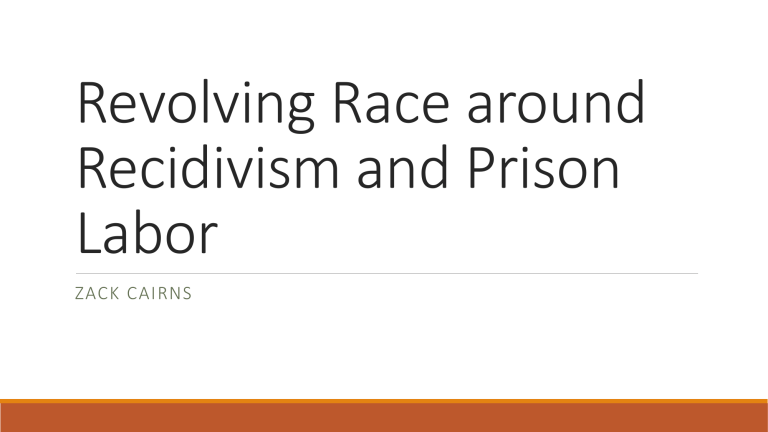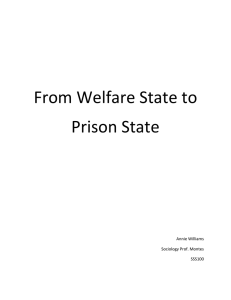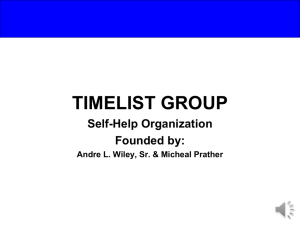Revolving Race around Recidivism and Prison Labor

Revolving Race around
Recidivism and Prison
Labor
ZACK CAIRNS
Research Question
How does the implementation of state prison work, educational, and vocational programs in OR, MN, WA affect recidivism rates and post-incarceration employment of racial groups?
Hypothesis
States with lower recidivism rates will have more whites imprisoned than states with high recidivism rates.
Why these programs?
Prison labor
◦ Federal Prison Industries (FPI) or UNICOR employs over 12,000 inmates to produce goods and provide services in exchange for developing qualities necessary for employment after prison
Education
◦ Basic (ABE), secondary (GED), and post-secondary
Vocational
◦ Training employment skills as well as trade-specific skills
Work Release
◦ Inmates with 8 months remaining in their sentence may qualify for employment outside of prison and are housed in alternate detention centers
Why these states?
Minnesota: highest recidivism rate - 61.2%
Oregon: lowest recidivism rate - 22.8%
Washington: recidivism rate increase of 10% between 2002-2007
Why racial groups?
Racial disparities persist beyond sentencing policy
Felon disenfranchisement
Questions the efficacy of our policies
Competing Views of Incarceration
◦ Robert P. Weiss
◦ “In exchange for enhanced labor rights, prisoner-workers are offered a category of citizenship lower than accorded free workers […]
This confronts prisoners in the“postmodern” penitentiary with a dilemma familiar to their free-world counterparts in the penal circuit: Stick to idleness and isolation, or work at hyperexploitative social production.”
◦ Hadar Aviram
◦ “The focus on private actors as the bogeymen of American incarceration belies a naïve understanding of neoliberal politics and a gross underestimation of the extent to which everyone—private and public actors alike—respond to market pressures and conduct their business,including correctional business […].”
Intervening Actors
Private Companies
Legislators
State Prisons
Government Agencies
Minnesota
State population: 5,420,380
◦ White: 86.2%
◦ Black: 5.7%
◦ Hispanic: 5%
◦ American Indian: 6.5%
◦ Prison population: 9,986
Racial Disparities
Vocational Program – Affordable Homes
Program (1998-2008)
◦ 350 person work crew program managed by Minnesota Department of Corrections in order to construct affordable housing, cut state costs, and train inmates
◦ Eligible prisoners – adult males
◦ Exhibit good behavior
◦ No violent actions/disturbances in past six months
◦ Paid $1.00-$1.50/hr
Program Results
Work Release Programs
3,570 offenders were released between 2007-2010
Washington
State population: 6,971,406
◦ White: 81.2%
◦ Black: 4%
◦ Hispanic: 11.9%
◦ American Indian: 6.5%
Prison population: 18,233
Racial Disparities
Work Release Programs
Study 1: Statewide findings of work release
◦ Hispanics were less likely to apply for work release than whites or blacks
◦ 40% of black and Hispanic were returned to prison compared to 25% white
Study 2: Impact of work release on recidivism
Offenders with a prior history of cocaine were more likely to receive infractions
Education
WA legislators prioritize PSE
Increased funding to the Early Childhood
Education Assistance Program in 2006 rather than invest in a new prison
Oregon
State Population: 3,930,065
◦ White: 88.1%
◦ Black: 2%
◦ Hispanic: 12.3%
◦ American Indian: 1.8%
Prison Population:
Racial Disparities
Prison Labor
The Prison Reform and Inmate Work Act (Measure
17) passed in 1994 requiring all inmates to be at work or enrolled in training programs 40-hours a week
Inmates are assigned to work crews and work alongside with state departments and communities
Develop practical skills and a strong work ethic
Work Release
For many states, technical violations are the reason for reverse reentry rather than new crimes
SB 267 requires evidence-based practices for drug and alcohol treatment
Analysis
Sociocultural
◦ Minnesota – Racial disparities in prison populations and vocational programs
◦ Oregon – History of inmate labor
Socioeconomic
◦ Washington – the decision to invest in education over prison construction is telling of how legislators look for cost-effective solutions
◦ Minnesota – employment favors a small segment of the prison population
*Political Institutions Oregon – SB 567, Measure 17
◦ Post-prison policies are unforgiving in other states
◦ Oregon - Referendum allows for testing new ideas
Legal Institution
◦ Washington – Work release programs favor whites
◦ Minnesota – Work release programs disfavor minorities
Recidivism
Bibliography
http://www.census.gov/compendia/statab/cats/law_enforcement_courts_prisons.html
- US census http://www.sentencingproject.org/doc/publications/rd_stateratesofincbyraceandethnicity.pdf
file:///C:/Users/Zack/Downloads/NorthcuttBohmert_Duwe_2011_CJPR-libre%20(1).pdf
http://www.census.gov/compendia/statab/2012/tables/12s0347.pdf
http://www.prisonpolicy.org/profiles/MN.html http://www.prisonpolicy.org/profiles/WA.html
http://www.indiana.gov/idoc/files/Work_Release1.pdf
http://2.bp.blogspot.com/-
IXeXxY4twLM/TbiCWrqFaRI/AAAAAAAAAWg/3bZuY_Xe7X0/s1600/Untitled%2B2.jpg
file:///C:/Users/Zack/Downloads/SSRN-id2492782%20(1).pdf






